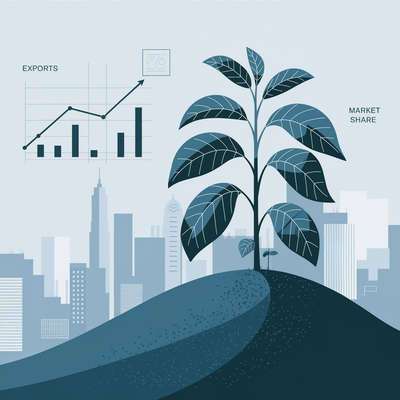2025 // Week 6 – Vietnam Pepper Market : Prices, Trends and Export Insights
Pepper Prices & Market Stability

As of February 2025, the Vietnamese pepper market demonstrates remarkable resilience, with prices maintaining a stable range between 151,000 to 152,000 VND/kg throughout the Lunar New Year period. This sustained pricing reflects robust market fundamentals, including consistent global demand, strategic inventory management by key producers, and steady export commitments. The market’s stability suggests strong underlying economic conditions and continued confidence among pepper traders and international buyers.

Harvest & Production Trends
Vietnam’s total pepper cultivation area encompasses approximately 113,000 hectares, with an estimated production of 190,000 tons. Although the main harvest season is approaching, this year’s harvest is expected to be delayed compared to previous years due to unfavorable weather conditions.
While some regions like Đắk Nông, Gia Lai, Bình Phước, Đồng Nai, and Bà Rịa – Vũng Tàu have reported positive trends, Đắk Lắk, the second-largest pepper-producing province, anticipates a decline in production due to farmers shifting to durian cultivation. This shift highlights a dynamic agricultural landscape in Vietnam, where market forces and economic incentives influence crop choices.

Exports and Industry Growth
In 2024, Vietnamese enterprises exported nearly 250,000 tons of pepper, achieving a record-high revenue of 1.31 billion USD, the highest level in the past eight years. Vietnam continues to hold the largest global stockpile, accounting for 40% of global production and 60% of worldwide exports.
The pepper industry witnessed strong growth in 2024, with companies reporting increases ranging from 32% to 68%, and some exporters experiencing a remarkable 150% surge in revenue compared to 2023. This growth reflects the high demand for Vietnamese pepper in international markets.

Experts predict that Vietnam’s pepper prices will remain high due to limited supply and stable demand in major markets like the U.S. and Europe. China’s stockpiles are gradually depleting, suggesting potential for increased imports in March-April.
Based on current market conditions, experts expect prices to remain stable at high levels in February 2025, before experiencing strong fluctuations in March-April 2025. This anticipation highlights the importance of monitoring market trends for both farmers and exporters to make informed decisions and mitigate risks from sudden supply-demand shifts.
International Market Insights
The International Pepper Community (IPC) reported a positive market outlook in the final week of January 2025, with no country reporting a production decline. While climate change in 2024 impacted pepper production, some regions experienced favorable weather conditions.
The VPSA’s assessment reveals a mixed picture across different regions. While some areas experienced stable or even increased production, others are facing challenges due to shifting agricultural practices and the impact of weather patterns.
The overall positive outlook from the IPC suggests a strong global demand for pepper, which will likely drive prices and maintain a healthy market environment.
For instance, in Đắk Nông, Vietnam’s pepper capital, production levels remained stable compared to last year. Similarly, Gia Lai, Bình Phước, Đồng Nai, and Bà Rịa – Vũng Tàu reported positive trends, as higher prices encouraged farmers to invest more in crop care and recovery of existing pepper plantations.
However, in Đắk Lắk, the second-largest pepper-producing province, production is expected to decline as many farmers switch to durian cultivation, and there is little new planting activity. Pepper harvesting is expected to last until the end of April 2025.

China’s Import Trends
In 2024, China reduced its imports of Vietnamese pepper by 82.4%, while increasing imports from Indonesia by 76.8%. However, China’s increased imports from Indonesia are still insufficient to meet its overall consumption demand.
China’s pepper inventory remains low, and expectations of a price drop did not materialize, as domestic prices have remained stable at 140,000 VND/kg over the past three months. This indicates a strong underlying demand in the Chinese market, despite reduced imports from Vietnam.
Forecasts suggest that China may wait until Vietnam’s main harvest season (after the Lunar New Year) before resuming large-scale purchases. This strategic approach aligns with China’s desire to secure advantageous pricing during periods of increased supply.
Global Market Outlook for 2025
Global pepper prices are expected to stay high in 2025 due to a continued decline in supply. Demand remains stable in major markets such as the U.S. and Europe. The food and spice processing industry remains the key driver of market demand.
This outlook indicates a favorable market environment for Vietnamese pepper producers and exporters in 2025. Continued high prices and stable demand will likely translate into continued profitability and growth for the industry.

